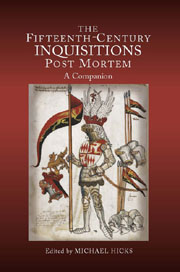Book contents
- Frontmatter
- Contents
- List of Tables and Figures
- List of Contributors
- Preface
- Glossary
- Abbreviations
- 1 Introduction
- 2 Crossing Generations: Dower, Jointure and Courtesy
- 3 The Lesser Landowners and the Inquisitions Post Mortem
- 4 Tales of Idiots, Signifying Something: Evidence of Process in the Inquisitions Post Mortem
- 5 The Value of Fifteenth-Century Inquisitions Post Mortem for Economic and Social History
- 6 ‘Notoriously Unreliable’: The Valuations and Extents
- 7 The Descriptions of Land Found in the Inquisitions Post Mortem and Feet of Fines: A Case Study of Berkshire
- 8 Re-assessing Josiah Russell's Measurements of Late Medieval Mortality using the Inquisitions Post Mortem
- 9 A Great Historical Enterprise: The Public Record Office and the Making of the Calendars of Inquisitions Post Mortem
- 10 Writs and the Inquisitions Post Mortem: How the Crown Managed the System
- 11 ‘Thrifty Men of the Country’? The Jurors and Their Role
- 12 Place-Names and Calendaring Practices
- Index
7 - The Descriptions of Land Found in the Inquisitions Post Mortem and Feet of Fines: A Case Study of Berkshire
Published online by Cambridge University Press: 05 February 2013
- Frontmatter
- Contents
- List of Tables and Figures
- List of Contributors
- Preface
- Glossary
- Abbreviations
- 1 Introduction
- 2 Crossing Generations: Dower, Jointure and Courtesy
- 3 The Lesser Landowners and the Inquisitions Post Mortem
- 4 Tales of Idiots, Signifying Something: Evidence of Process in the Inquisitions Post Mortem
- 5 The Value of Fifteenth-Century Inquisitions Post Mortem for Economic and Social History
- 6 ‘Notoriously Unreliable’: The Valuations and Extents
- 7 The Descriptions of Land Found in the Inquisitions Post Mortem and Feet of Fines: A Case Study of Berkshire
- 8 Re-assessing Josiah Russell's Measurements of Late Medieval Mortality using the Inquisitions Post Mortem
- 9 A Great Historical Enterprise: The Public Record Office and the Making of the Calendars of Inquisitions Post Mortem
- 10 Writs and the Inquisitions Post Mortem: How the Crown Managed the System
- 11 ‘Thrifty Men of the Country’? The Jurors and Their Role
- 12 Place-Names and Calendaring Practices
- Index
Summary
The purpose of this chapter is to argue that we can have greater confidence in the descriptions of land contained in inquisitions post mortem than previously held. Whilst there may be significant problems with individual descriptions, IPMs can become a very useful source of quantifiable data, if employed quantitatively, in conjunction with other sources of evidence, and with a realistic acknowledgement of what they can and cannot reasonably be expected to reveal. The evidence on which this assertion is based is drawn from a case study of Berkshire which looks backwards to the earlier period at the beginning of the fourteenth century, before considering the data from the fifteenth century. It is based on a comparative analysis of the descriptions of land contained in the IPMs and those of the legal record commonly known as feet of fines. Having established the comparability of the two sources, the chapter employs their data to demonstrate their potential for an investigation of agricultural change over these two centuries.
Discerning fact from fiction in many of the formulaic documentary sources of the medieval period remains a perennial problem for historians. A previous attempt was made to get behind the language of the (in that instance manorial) documents to conditions on the ground in the two contrasting regions of Norfolk and Berkshire. The conclusions reached were that legal structures were not detached from the underlying economic situation and that when manorial documents were employed in conjunction with other sources of evidence a more accurate account of conditions could be obtained.
- Type
- Chapter
- Information
- The Fifteenth-Century Inquisitions 'Post Mortem'A Companion, pp. 145 - 154Publisher: Boydell & BrewerPrint publication year: 2012



